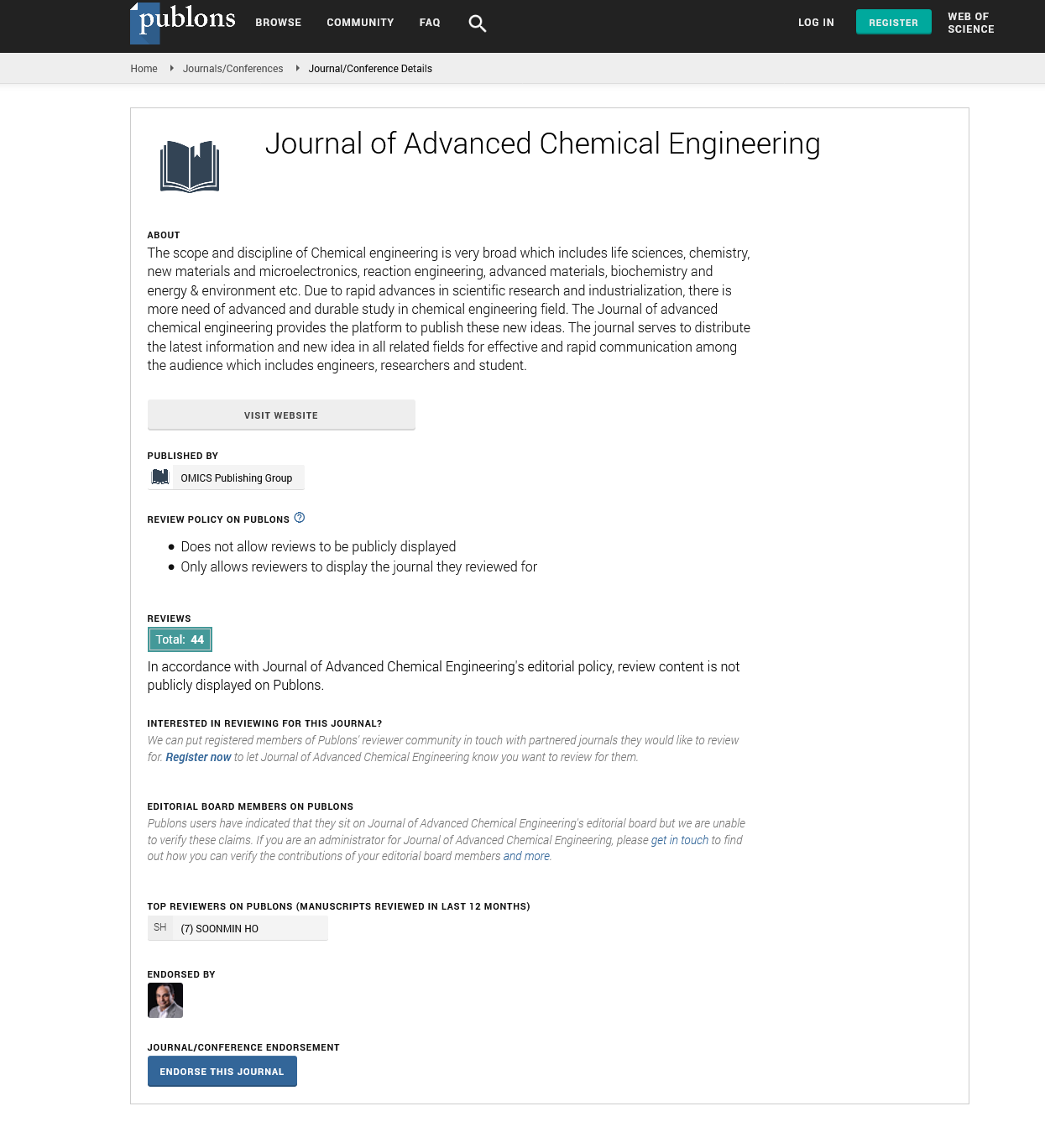Indexed In
- Open J Gate
- Genamics JournalSeek
- Smithers Rapra
- RefSeek
- Directory of Research Journal Indexing (DRJI)
- Hamdard University
- EBSCO A-Z
- OCLC- WorldCat
- Scholarsteer
- Publons
- Geneva Foundation for Medical Education and Research
- Google Scholar
Useful Links
Share This Page
Journal Flyer

Open Access Journals
- Agri and Aquaculture
- Biochemistry
- Bioinformatics & Systems Biology
- Business & Management
- Chemistry
- Clinical Sciences
- Engineering
- Food & Nutrition
- General Science
- Genetics & Molecular Biology
- Immunology & Microbiology
- Medical Sciences
- Neuroscience & Psychology
- Nursing & Health Care
- Pharmaceutical Sciences
Commentary - (2022) Volume 12, Issue 11
Chemical Process and its Aspects in Organic Solvents
Jason Oliver*Received: 02-Nov-2022, Manuscript No. JACE-22-19152; Editor assigned: 07-Nov-2022, Pre QC No. JACE-22-19152 (PQ); Reviewed: 22-Nov-2022, QC No. JACE-22-19152; Revised: 28-Nov-2022, Manuscript No. JACE-22-19152 (R); Published: 06-Dec-2022, DOI: 10.35248/2090-4568.22.12.259
Description
The fundamental process when thinking about chemical reactions is the interaction between the pore fluid and the solid grain minerals, particularly the surface minerals. Due to their effectiveness in numerous unit activities, volatile organic solvents have been used extensively in chemical processes. The growing understanding of the risks to the environment, human health, and safety connected with their use has greatly aided the quest for environmentally friendly substitutes. The primary objective is to provide an overview of safer alternatives to harmful organic solvents that have successfully replaced them in common chemical procedures and processes.
Through enhanced mass and heat transfer, the application of external force fields, improved driving forces, and combinations of various unit operations, such as reaction and separation, in single-process equipment, modular chemical process intensification can significantly increase the energy and process efficiencies of chemical processes. Numerous advantages result from these significant advancements, including compactness or a small environmental footprint, cost and energy savings, increased safety, decreased waste production, and better product quality.
Process intensification can be very important in the industrial and manufacturing sectors, such as chemical, pulp and paper, energy, critical materials, and water treatment, among others, because of these advantages. In order to support future development and potential applications of modular chemical process intensification in the industrial and manufacturing sectors, this article provides an overview of process intensification, including definitions, principles, tools, and potential applications.
An overview of the plasma chemical reactions that take place in the volume of electrical nonequilibrium discharges is given. It is discussed how energectic electons act as chemical reaction catalysts in a cold background gas. We explore the appropriateness of several discharge types (glow, corona, quiet, RF, and microwave discharges) for plasma processing. The necessity of starting and maintaining the discharge while simultaneously improving plasma parameters for the desired chemical reaction is stressed. The detailed discharge optimization procedure is given using the large-scale industrial ozone production as an example. Other plasma chemical synthesis processes as well as breakdown procedures like flue gas treatment and hazardous waste disposal are other applications of volume plasma processing.
Due to a developing understanding of the effects of solvents on pollution, energy consumption, contributions to air quality and climate change, sustainable solvents are a topic of increasing interest in both the research community and the chemical industry. Solvent removal accounts for a sizable component of process energy use while solvent losses account for a significant portion of organic pollutants. Over the past three decades, a variety of greener or more sustainable solvents have been proposed and created to address these problems. The solvent's environmental credentials have received a lot of attention, but the way a chemical is used is just as crucial to sustainability as the materials it is made of.
Conclusion
The most popular sustainable organic solvents now in use-ionic liquids, deep eutectic solvents, supercritical fluids, switchable solvents, liquid polymers, and renewable solvents-Ionic liquids, deep eutectic solvents, supercritical fluids, switchable solvents, liquid polymers, and renewable solvents-the most widely used sustainable organic solvents now in use-are addressed in terms of a variety of distinct aspects. In addition to evaluating the effectiveness of each type of solvent in the context of the reactions or extractions for which it is employed, we can also evaluate the process and system in which the solvent is utilised.. In order to provide a more thorough picture of the current state of sustainable solvent research and development, a wide range of technical, economic, and environmental variables are taken into consideration. Due to their unique material removal techniques, electro-physical and chemical micromachining procedures play a significant role in this industry. The latest technological advancements and electro-physical and chemical micromachining processes are covered in this article. Standardization, metrology, and equipment design issues relating to supporting technologies are briefly evaluated.
Citation: Oliver J (2022) Chemical Process and its Aspects in Organic Solvents. Adv Chem Eng.12:259.
Copyright: © 2022 Oliver J. This is an open-access article distributed under the terms of the Creative Commons Attribution License, which permits unrestricted use, distribution, and reproduction in any medium, provided the original author and source are credited.

